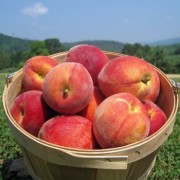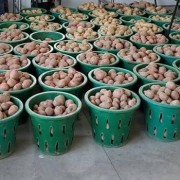11 summer superfoods to boost health
Plus recipes for each one!
Summer is Mother Nature’s blockbuster season. Some faves come early, some late, and some keep coming all summer long. There are dozens of summer superfoods, but here are 11 rock stars — complete with health benefits, harvest season, and a link to a delicious, do-able recipe for each one from our Pinterest library.
Basil
This fragrant herb is popular for its flavor. Its impressive nutrition content is less well known, but it’s actually a great source for vitamin K, manganese, and magnesium, with strong antioxidant and antibacterial qualities. Together they help fight illness and infection. Add to a salad or marinade, sprinkle over berries and ice cream, or tear it into a summer cocktail. Virginia harvest season: May-November. Try this recipe: Easy Caprese Salad
Bell Peppers
All colors of sweet bell peppers deliver plenty of vitamin C, as well as some fiber and vitamin B6. Red peppers also contain beta-carotene and lycopene, antioxidants that help prevent cancer, improve cognitive function, and support healthy lungs and skin. Those red colored peppers also give you twice the amount of vitamin C you’d get from a citrus orange. Virginia harvest season: June-August. Try this recipe: Spanish Quinoa Stuffed Peppers
Cherries
These antioxidant-packed fruits contain anthocyanins, the flavonoids that give cherries their deep red color along with some serious superpowers. They help regulate immune responses and act as an anti-inflammatory. The sour varieties of this fruit may be even more helpful as an anti-inflammatory. In fact, studies suggest tart cherries could be more effective than aspirin at relieving pain and reducing inflammation. Virginia harvest season: May-August. Try this recipe: Cherry Bread Pudding
Eggplant
It’s one of the world’s healthiest foods. The anthocyanins in it protect heart health. Its nasunin may help improve blood flow to the brain. It also contains chlorogenic acid, a powerful free-radical scavenger that helps prevent cancer. It supports strong bones, boosts cognition, and protects the digestive system. Virginia harvest season: June-August. Try this recipe: Eggplant Rollatini with Spinach
Grapes
Sweet and tangy and bursting with antioxidants, grapes are a good source of vitamin K. That helps blood clot and may contribute to strong bones. A study in Experimental Gerontology found that eating grapes twice a day for six months protected against metabolic decline in regions of the brain associated with early Alzheimer’s disease, and enriched metabolic activity in areas of the brain related to memory and attention. You can snack on them fresh, frozen, or add to salads, salsas, or smoothies. Virginia harvest season: August-October. Try this recipe: Muscadine Almond Smoothie
Peaches
Every time you bite into a juicy summer peach, you’re getting a dose of antioxidants, vitamins C and A, and potassium. Potassium plays an important role in regulating blood pressure and may aid in muscle recovery after a workout. Virginia harvest season: June-September. Try this recipe: Balsamic Peach Chicken
Summer Squash
Zucchini and yellow squash are excellent sources of vitamin C and antioxidants for a strong immune system and good eye health. Use a spiralizer to make a healthy pasta substitute, chop them up and add raw to a grain salad, or brush slices with olive oil and grill. Virginia harvest season: May-September. Try this recipe: Summer Squash, Bacon & Mozzarella Quiche
Sweet Corn
Is it a veggie or a grain? One thing we can be sure of is that it’s a rich source of vitamin B1, vitamin B5, vitamin C, phosphorus, manganese, folate, and fiber. All of which means that, on or off the cob, it’s good for your heart, eyes, cancer prevention, and memory enhancement. Virginia harvest season: June-August. Try this recipe: Cowboy Caviar
Swiss Chard
This dark leafy green may look like it belongs in winter, but it reaches its peak during summer. It’s also full of cancer-fighting antioxidants, as well as magnesium, which helps fight depression and migraines, and control blood sugar levels. It’s also got potassium for good blood pressure, heart health, and bone and muscle strength. Add to your salad mix, use it as a sandwich or burger wrap, steam it, or add it to soups and stews. Virginia harvest season: All summer. Try this recipe: Swiss Chard Rolls
Tomatoes
These guys deliver an army of antioxidants that have been shown to fight various cancers. They’re also a rich source of vitamins like vitamin C and the beta-carotene that makes them red also makes them good for your eyes and skin. Minerals like potassium and phosphorus protect against cardiovascular disease, build strong bones and teeth, and help reduce blood pressure and inflammation. They detoxify the body and are good for your stomach and urinary tract. Virginia harvest season: July-October. Try this recipe: Tuscan Lentil Soup
Watermelon
Low in sugar and high in vitamins A and C, this summer treat can be eaten as a refreshing snack, a low-calorie dessert, or part of larger dish. Studies suggest watermelon may lower blood pressure and reduce risk of cardiovascular disease. Plus the lycopene in watermelon could help protect the body from UV rays and cancer. Virginia harvest season: June-August. Try this recipe: Watermelon Salad with Mint & Crispy Prosciutto
ABOUT SEASONAL ROOTS
Since 2011. , Seasonal Roots’ online farmers market has connected Virginia families with local family farmers who use sustainable, humane practices. Our veggie fairies – mostly moms who believe in living better through scrumptious, healthy eating, being kind to animals, protecting the environment, and spreading joy – home-deliver freshly harvested produce, eggs, grass-fed dairy and meat, plus artisan fare. We empower our members to eat better and live better with more nutritious, flavorful food that’s good for us and good for the planet. More info at seasonalroots.com.




